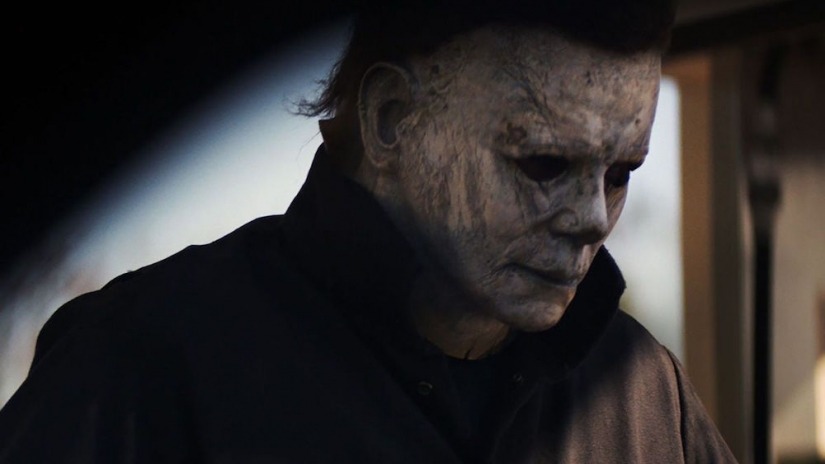
Isn’t that mask just so expressive? It’s supposed to make Michael Myers faceless, but really it kind of gives him a soul. A dark, evil, tortured soul. Anyway, I think it’s going to be a touch before I get to actually talking about this latest version, BUT:
- if you haven’t seen it yet
- AND you don’t like spoilers
- AND you can’t help but finish every post you start reading, then:
- maybe don’t start this one yet?
Which is to say, spoilers will abound. But I don’t don’t don’t want to mess up anybody’s experience of this the first time around. That’s unforgivable. So, please, for my conscience if for nothing else, consider yourself warned.
Another warning: for me any slasher on the dissection table is also every slasher in the canon or even canon-adjacent. I can’t talk about one alone, it’s always all of them together, for better or worse, until death do they part and they never-never die. So, that’s what I’m about do here/again, I suspect: talk about the genre as triggered by this one film, and see what I can’t uncover, or take a stab at.
And . . . I think I’ll do this in parts, maybe—no, sections:
The Slasher Build
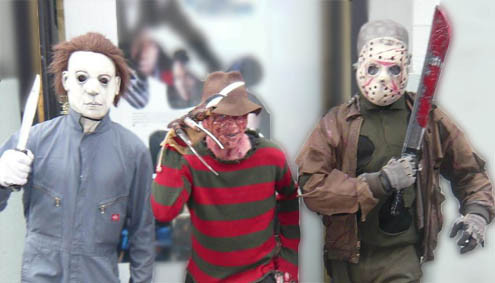
Halloween is of course the darling child of the slasher. And it deserves to be, I’m not meaning to chip away at that at all. Part of that hallowing of Halloween, though, always seems to be bad talking Friday the 13th, doesn’t it? People always say that:
- Friday the 13th kind of corrupted the slasher build that John Carpenter and Debra Hill so deftly laid out
- Friday the 13th isn’t half the film Halloween is
I can run with the second one, there. Where Friday the 13th is excessive, Halloween is restrained. Where Friday trades in gore and transgression and pretty laughable dialogue, Halloween traffics in dread and suspense, in misdirection and loaded backgrounds, in people who talk like people. So, yes, Halloween is more a descendent of Psycho, whereas Friday is built on the Bay of Blood model: one set-piece kill after another, each trying to outdo the last in terms of inventiveness and awfulness, where the story is distant second to the spectacle. In Halloween the fun is in the stalking, while in Friday the 13th the fun is in the kill.
This isn’t to say I don’t dig me some Friday the 13th, of course—it’s closest to my heart—and I don’t mean to try to make some distinction between ‘cinema’ and ‘movies,’ and yes, of course Sean Cunningham was cashing in on Halloween‘s success (nothing wrong with keeping your finger on the market’s pulse and making a buck), but I get what people are saying about these two titans of our first slasher boom.
However, technique and artistry and all that aside, did Friday the 13th really, right out of the gate, corrupt the slasher formula Halloween had just laid down, whether it intended to or not (and making all proper obeisances to Black Christmas, to Class Reunion, to Savage Weekend, to The Flesh & Blood Show, etc)? I don’t think so.
Let’s look at what Friday the 13th does: like nearly ever slasher that’s lasted, it opens with a transgression of some sort, a “crime,” which I call the Prank—just, something that’s unfair, that leaves a victim, that’s usually perpetrated by more than one person. In this case, the Prank is those two counselors sneaking off to have sex while kid-Jason drowns. This neglect is ‘punished’ the following year, when a couple of those counselors—possibly THE guilty counselors?-—are killed. Blood for blood, all that. Then, many years later, when more counselors show up, they, being counselors as well, are similarly dispatched, because they’ve surely got that same reckless, neglectful impulse.
So:
- the Prank leaves a victim
- there’s more than one Prankster
- later, that victim (or, in Friday‘s case, the victim’s avenger) rises to seek justice, punish the guilty . . . and usually gets pretty carried away, at which point
- a final girl rises to put a cap on this cycle
But, really, for purposes of comparison, the first three are enough (and it’s surely possible to phrase 1 and 2 into a single bulletpoint).
Now, people are always saying that Halloween is different, that it’s not so inelegant as all that. But, I mean, look at like this, maybe?
- Kid-Michal’s big sister is supposed to be babysitting him, but instead she and her boyfriend sneak off to have sex, neglecting her assigned duties
- Kid-Michael punishes her for that transgression immediately, and then, years later . . .
- He comes back all grown up, to punish the next girl he identifies as a ‘big sister’/babysitter, Laurie Strode
As for how that cross-identification happens: Michael’s standing behind the door of his old house when Laurie and little Tommy approach, talking in a way that establishes that she’s watching out for him tonight. That’s all Michael needs: not only is she acting like a big sister to a boy about the age he was when his sister ‘abandoned’ him, but she’s ALSO right here where it all happened. So he naturally targets her, and, just like Pamela and Jason Voorhees, widens that lens as well, to include everyone in that ‘babysitter’ class (and anybody who gets in the way). I mean, take into account that John Carpenter and Debra Hill had been tasked with writing “The Babysitter Murders,” then of course the first story problem to solve is Why babysitters? The easy and pretty much first answer to that, it’s: Because they’re not being good babysitters. Why else harbor this all-consuming anger towards them? The twist Carpenter and Hill brought to the table, then, it was that who felt the most offended by that inattentiveness wasn’t the parents, like you’d think, but the babysat—kid-Michael.
Sure, maybe Loomis is right and Michael Myers is ‘evil,’ but, still, he wasn’t always, right? They didn’t chain him to a wall for his first five years, they didn’t have all the weapons in the house locked up. No, something DID that to him. Granted, the thing that flipped that switch in his head or heart or knife-hand, it was slight and pretty forgivable, but how much a thing hurts always has to be gauged by the one being hurt, not by anyone on the outside. Perhaps kid-Michael had some serious attachment issues, which his sister carelessly, from his point of view, betrayed. Or maybe he was just really insulted by her making her boyfriend more important than her little brother. Or maybe he didn’t just love her, he was IN love with her, and didn’t like being displaced.
So, to me, Cunningham upped the slasher’s gore and violence, dialed back the dread and suspense, sure—he changed the operative punctuation mark of the slasher from ellipses to exclamation points—but he wasn’t really perverting the slasher’s fundamental dynamic. He was just copying pretty much exactly what Halloween had done so successfully. The only difference was he let the dynamic, the build, be more visible, more on the surface.
Too, while we’re on this? A Nightmare on Elm Street is just the same:
- Freddy Krueger is burned by a mob, which is a big transgression, going around the legal system to exact vigilante justice. He was guilty, sure, but it still wasn’t fair to do that to him
- Years later, Freddy comes back to punish that mob by continuing what he was doing: abducting their children (into dreams) and killing them, which is basically just telling him they were right about his guilt / rubbing it in their grieving faces.
- A final girl rises, essentially saying “we’re not them, this isn’t fair,” and puts a stop to this cycle of violence.
Leatherface, though, and in spite of how great he looks in a four-pack with Michael and Jason and Freddy, was only ‘pranked’ in the sense that he was born into a family that’s turned to cannibalism. He doesn’t have any axe to grind, just a boning knife to keep sharp, so, he may have a signature weapon and be scary as all get out and wear a killer mask, but he’s no slasher.
Ghostface, though: the Prank/transgression there is when Sydney’s mom has an affair with Billy’s dad, breaking that family up. Billy retaliates by, of course, killing Sydney’s mom, but he doesn’t stop there, also going after Sydney herself, as she’s guilty by association (slashers’ sense of ‘guilty by association’ is pretty loose/all-encompassing).
All of which is to say, what Michael’s doing in 1978 and in 2018, it’s the same thing Jason’s been doing for ten-plus movies: killing Halloween‘s version of camp counselors. He’s maniacally fixated and cuts a wide swath getting to those babysitters, sure—to one in particular—but, really, him and Jason are pretty much the same slasher: masked, wordless, unconcerned with bullets, too dignified to ever resort to running.
Too of course, a staple of the slasher genre is pairing the viewer up with that slasher, right? You can see it great in, of all places, Jaws, where the deadly breathing is replaced by those two piano keys, but sometimes it’s good to just hear the close breathing inside that mask, too, as when we’re locked into
Michael’s POV
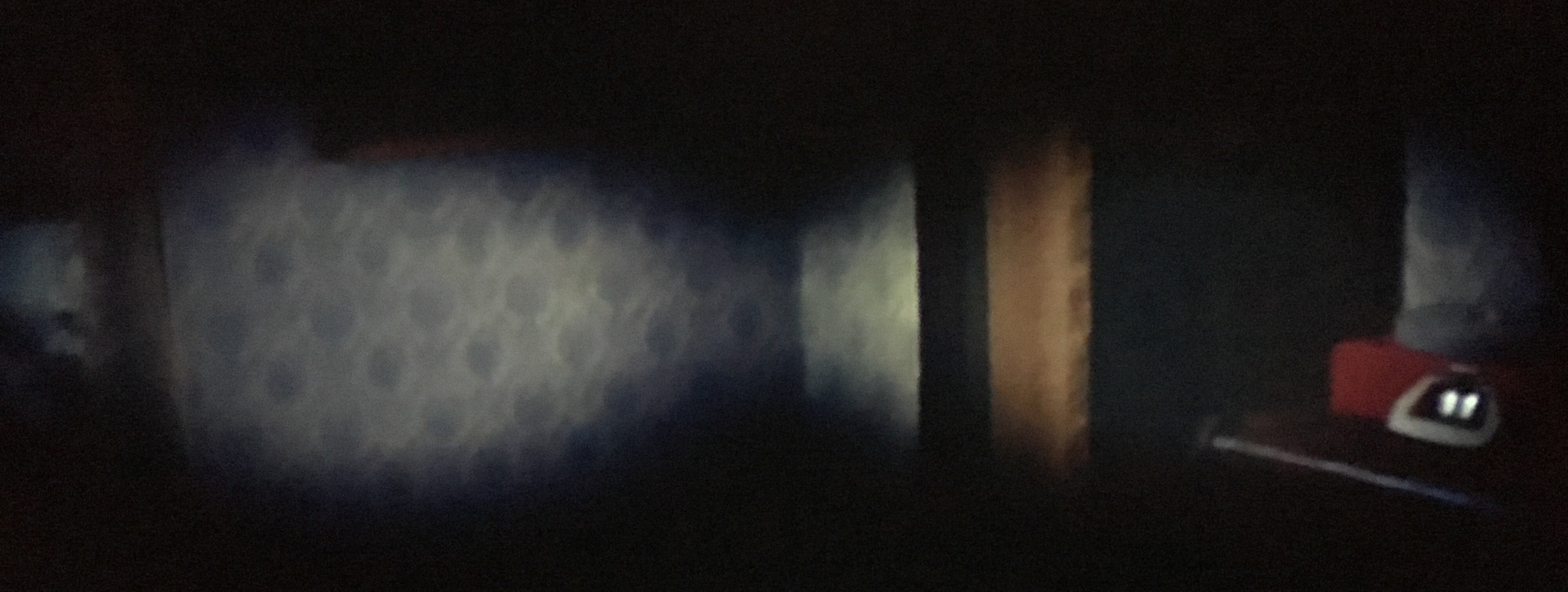
Couple nights ago, after hitting an early screening of Halloween 2018, I cued up the 78 Halloween, to see if I was missing anything. To try to defamiliarize myself with it—who knows how many times I’ve seen it—this time I tried to see it all as Michael was . . . sort of. Which immediately became a to-do list for him:
- Kill Judith. She was supposed to be babysitting you (“[Michael]’s around here somewhere”), was having sex instead. Killing her PROVES she should have been paying attention
- Stay in the asylum fifteen years, staring at the wall, staring THROUGH the wall, waiting for a silent alarm. Don’t say anything
- Break out the night before the fifteenth anniversary (alarm must have rung)
- Steal a station wagon, drive it somehow
- Take off for Haddonfield
- Kill a pickup driver on way, steal his overalls
- Break into a hardware store, steal what you need (knives, mask, rope)
- Get to Haddonfield, stay in your old house, eat a dog, steal Judith’s headstone (which I guess is what the rope’s for, to haul that heavy slab of granite on your back?)
- Meet Laurie and the boy Tommy, key on their brother/sister dynamic
- Stake Laurie’s school out, because, being a big sister type AND a babysitter, she really needs to die, but the killing’s of course sweeter when the prey’s been systematically terrorized
- Track Tommy at his school, possibly because you somehow lost Laurie, but know she’ll be meeting up with Tommy at some point (or is this six-year-old Michael returning to the terrain he remembers?)
- Cruise around, luck onto Laurie, brake ominously when her friend Annie yells at you about speeding
- Stand behind a bush that’s in Laurie’s path, then run away fast
- Stand by Laurie’s laundry line, then run away fast
- Drive right behind Annie and Laurie, which leads past the hardware store crime scene
- Track Annie to her babysitting gig, not because she’s your target (you don’t know she’s a babysitter yet, just that her and Laurie tend to be around each other), but because she has the car Laurie is/was in, and it’s the CAR you’re tracking
- Go leave your stolen station wagon back at old house? (possible IF the old house is close enough Dr. Loomis can walk between them, which he does. All the same, Laurie can walk to the old house from HER house, but when Annie drives them to their babysitting houses, it takes them through downtown (the hardware store). Maybe Haddonfield’s streets are mobius affairs)
- ( Get seen as the boogeyman by Tommy from across street, which is maybe not on purpose? )
- Kill the loud dog by hugging it, you giant dangerous six-year-old boy, you
- Hide in Annie’s car, kill her, don’t worry about the super loud horn
- Carry Annie around the house to bring her inside to “be” Judith (headstone was in the station wagon? seriously? wouldn’t we have seen the car’s tail dragging?)
- Spy on Bob and Lynda at the house Annie was babysitting at (they’re there to hang, drink, have sex)
- Spy on them upstairs having sex
- Come downstairs to kill Bob, stick him to the wall with a knife, never mind how difficult that would be to actually DO
- Go upstairs in a hilarious sheet (this a repeat of wearing a costume to kill Judith?), kill Lynda with phone cord then listen to Laurie on the line
- Turn the downstairs lights on and off, who knows why
- Hide Lynda and Bob in same room/tableau as Annie, as setup for Laurie’s Third-Reel Bodydump. She’s not going to terrorize herself, right?
- Laurie’s in the house! Stab/slice her in the left arm/shoulder very poorly, in spite of the fact that you’re pretty good with that knife otherwise, and not bad at killing either (one explanation: buck fever). Then stalk her through house more seriously
- Chase her VERY calmly, like, Panaglide calmly, back to the house she’s now at, across the street
- Come in through an open window …
- Try to stab her NOW over the back of the couch, but get stabbed in the neck with a crochet needle. Pass out from that
- Wake, walk upstairs knife-first
- Go at Laurie in a closet, catch a clothes hanger in the eye, then your own knife in the chest
- “Die”
- Sit up from the waist like an old-timey vampire (sitting up like this means you’re ‘beyond death,’ which is pretty disconcerting)
- Lose your mask in a Laurie-scuffle, but desperately want it back, NEED it back, you’re so distraught to be SEEN
- Try to strangle Laurie but catch six bullets from the doctor, fall off the balcony onto the lawn
- “Die”
- Run away fast
- Breathe loud in that mask
- [according to 2018: get caught]
- [according to 2018: wait forty years]
That track, more or less? It’s solid, it’s simple, it’s, yes, elegant. I bet It Follows breaks down very similarly, even though the ‘you’ would be more diffuse.
Anyway, to note, maybe, is that what became prevalent in the Golden Age of slashers, that whole “sex/drinking/drugs is punishable by death”-thing, it’s pretty absent here, yes? Seems I heard Carpenter say somewhere that it makes good sense to try to kill someone when they’re having sex, since they’re naked and vulnerable, and probably not paying proper attention to any skulkers sneaking up, blade in hand. Same with drinking and drugs: when someone’s impaired, they’re so much easier to come at. So, Halloween wasn’t necessarily trying to ‘code’ certain behaviors as being bad, or punishable offenses. But, yes, maybe Friday the 13th does push or allow this reading, which kind of makes slashers into tales cautioning us against sex and drugs and rock n roll, which then makes them a tool parents and society can use to keep us (‘teens’) on the straight and narrow. The gore and transgression and general uselessness of authority in slashers is just smoke, to make us think these are for and by us. Really, they’re only for us.
And, yes, it’s hard to deny that there’s some of this going on in the genre as a whole. It’s even harder not to read slashers as cautionary tales. But they’re not necessarily concerned with sex, with keg parties, with toking up out in the car. They’re concerned with showing us the possible consequences of not taking other’s feelings or personhood into account. Take that kid who’s pranked up front in Terror Train, right? He thinks he’s about to have sex, but ends up in bed with a corpse, which is hilarious to the privileged crew having fun at his expense. At least, it’s hilarious until later.
To me, that’s the main pleasure involved with the slasher: it’s a closed system of justice. The people being targeted for death are generally those who are asking for it. When they die in their various ways, we don’t feel bad, since they’ve brought it on themselves, more or less (all the collateral damage is trickier to justify, but hey: no kid gloves in slasherland). Granted, it’s less a lesson, more a sentence, but, for us it can be a lesson: don’t be part of the many, using others for your transitory, cruel entertainment; uphold the duties you’ve been tasked with, camp counselors, babysitters, all of yo with some degree of power.
But what’s also so wonderful about slashers is the fantasy they engage: a fair world; a world in which the guilty don’t get off scot-free, but are punished, and punished hard. Wouldn’t it be great to live in a world where nature or the world would, when insulted enough by a crime/prank/transgression, kick an agent up to rebalance those scales?
It’s not the world we actually live in, no. But, dangerousness aside, its nice to pretend for eighty or ninety bloody minutes, isn’t it? No, Laurie and her friends don’t deserve to have Michael coming for them. Well, Laurie doesn’t anyway. Annie, though, she’s pretty much Judith—thus the headstone she gets staged with. One thing that nearly always holds true with the slasher, it’s that it’s a closed system of justice. Which will matter a touch, come
2018
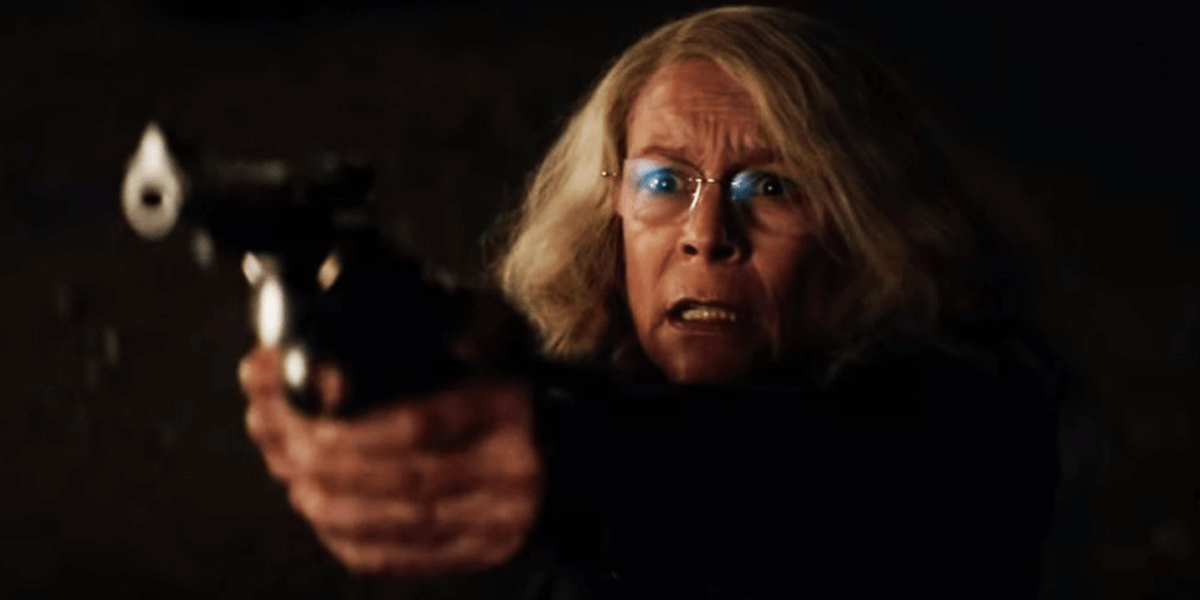
As far as horror sequels go, this is one of the all-time best, is right up there with The Descent II, with Prom Night II. And it’s kind of THE formula for how to make a proper horror sequel: first, identity the key characteristic of the original, and understand that whatever story you write for this one, it’s got to ring all those same bells, with twists. It’s what the audience is expecting, without quite being able to articulate exactly that, even if they’re Randy from Scream. So, coming out of 1978, and dismissing all the sequels since then, 2018’s Halloween knew it had to ring these key bells:
- ominous figure standing outside school
- mental patients milling around after a breakout
- kids running into Michael on the sidewalk
- Michael in a backseat
- partially seeing a stripped, dead ‘driver’
- Michael sitting up in his creepy from-the-waist way
- three school friends walking on a sidewalk
- the mask we know and love and need
- someone gone after a fall from a balcony
- dead person’s face honking the car horn
- old horror on the television
- the killer in the background getting slowly lit up . . .
- a sheet-ghost
- a scary laundry line
- Michael surviving MUCH physical damage
- his doctor speechifying about him
- Halloween night, where a masked person can walk around ‘invisible’ . . .
All of which Halloween absolutely delivers, and twists up for us, getting us to clap just from pure happiness. And it even delivers stuff we didn’t know to want: Laurie’s straw hat on the wall again; that crochet-hook hole in the neck of Michael’s mask; one of Michael’s eyes being cloudy with old injury; a NEW Loomis (!).
Just as important, and this is what really gets this Halloween to land: the humor. So many horror creators think that horror needs to be grim and dark ONLY. This is not the case. Horror is all about tension, but we need staggered pressure release valves, which is what the laughs give us, allowing the tension to start to build back up again. This is where this Halloween actually excels past the original, I think: it’s legitimately funny, and with such throwaway stuff. Example: someone’s setting a mousetrap with peanut butter, and gets . . . I’ll let him say it: “Oh, man, I got peanut butter on my penis.” This cracked the theater up both times I’ve seen this.*
Too, quick aside here: anybody else noticed that creators with a background in comedy are kind of owning horror lately? Jordan Peele with Get Out, John Krasinski with A Quiet Place, Danny McBride here with Halloween? Or, look at it the other way: didn’t Bob Clark use the same chops to do Porky’s that he’d already used with Black Christmas? Why this horror/comedy crossover? I think it’s because horror and comedy are each built the same, like jokes: tension tension tension . . . release. I read somewhere once that, until the moment of eruption, a laugh and a scream are physiologically indistinguishable. I buy that. That’s a big part of the pleasure of engaging horror: you don’t know what’s about to come out your mouth this time, a laugh or a scream. Or, watch those night-cam audience reaction clips, where a scream is always FOLLOWED by a laugh (but that may have something to do with serotonin release after a spike of adrenaline, too**, or be dependent upon a group dynamic).
Aside from the excellently-deployed comedy, though, there’s also some way cool stuff this time around:
- when Laurie says to the new mental health doctor “You’re the new Loomis,” he shakes his head no, no (which I only caught the second time around)
- a few scenes after Michael’s taken a graphic shotgun blast to the hand, he’s real sure to stand in silhouette long enough that we have to see his two fingers hanging down: this is the SECOND instalment, folks. Be cool for this to be the cover image for the DVD
And of course there’s . . . I don’t want to say “missed opportunities,” but there’s one revolver that’s for-sure placed up on the mantle but then we never see it in action: that boyfriend’s M-80 (or whatever) firecrackers. Why does he pick up a KNIFE to go after Michael, completely forgetting about his firecrackers? For that matter, the motorcycle he’s revving up right before that could have paired up nicely with some firecracker action, I have to think. He’s a smart, capable kid. I wonder if he would really dive headfirst into a meatgrinder.
But, that’s probably just a leftover stub in the script, I suspect—something that was in the can, would have been complicated to reshoot.
Much more important, I think, is what I’ve been meaning to get to all along: the sense of justice in Halloween.
Minor example first: Cameron, the cheater boyfriend, gets to live? Isn’t he being set up TO die, pretty much? In slasher terms, he’s asking for it. Or is this Halloween saying that the deaths here are arbitrary? I would believe that, except that guy who kisses Allyson (Laurie’s granddaughter) without invitation and in a kind of aggressive way, HE gets the blade in the back immediately after. But Cameron the cheater, the phone destroyer, gets a pass? Is it because he was more a plot function than a character, maybe? I mean, what he DOES is A) separate Allyson from the safety of her parents, and then B) cut off all communication with that safety. Once he’s checked those two off his list, he’s free to go back to the dance, I guess? It’s the only thing I can come up with. I don’t think this is a matter of saving him for the sequel, anyway. All we’d be doing there is rooting for him to die.
So, that’s my minor hesitation with the justice system in this Halloween. My major hesitation? It involves justice as well, but it expresses as what became wrong with Scream, as the franchise continued and continued: too many people live. I mean, the survivors and overcomers of the slasher are called “Final Girls” for a reason, aren’t they? It’s not because there’s a lot of them, it’s because there’s ONE of them at the end, slathered in blood, breathing hard, probably damaged for life, as Last Girl Standing illustrates.
What I’m getting at is my sense that Karen, at least, should have died. That’s Laurie’s daughter, Allyson’s mom. This would lend closure to the cycle of justice that, save Cameron, has pretty much been operant throughout Halloween, and is always percolating through driving the slasher genre.
I mean, Karen, she’s been a pretty disloyal daughter to Laurie, hasn’t she? But she can be that way, she can disrespect her mom and all her lessons for this long, and get a PASS on that? NOT have it come around to bite her? I don’t think so. Yes, I want the training she thought useless to become vital, to get them out of a pinch, that’s a wonderful turn, but it means so much more if she does it to save her daughter. Remember when Ashley Judd’s character in the Divergent series suddenly reveals all her training to save her daughter? It’s a magical perfect moment. And she dies right after that, because she’s now climbed as high as she can, and gets a graceful, meaningful exit.
And, to be sure, I’m not at all trying to suggest or support that women on screen are only interesting when they die. Hopefully that’s not what’s coming across, here. I have heard people saying that Halloween is a feminist slasher (feminist in a different way than The Slumber Party Massacre, yes), and in the sense that it’s not objectifying women, that’s it allowing them to be capable, not just damsels, yes, it’s doing some good and necessary work—taking up the slack for other, less helpful slashers, of which there’s always too many (I just said that, yes: “too many slashers”). But, I mean, ideally all horror these days would be less exploitive, more responsible, right? That doesn’t mean coddling all the female characters in a film to safety, though. That’s just as insulting as ever, is framing women as fragile, in need of protection, unable to bowl without the bumpers in place.
No, what I take to be an ideal feminist approach in the slasher has more to do with leveling the playing (killing) field. You’re Next, say? Or Kristy? That’s how you do it, I think, and that’s what the slasher is built so well for: to showcase that a woman doesn’t have to be the victim, that she can turn the tables, save herself WITHOUT any help.*** The problem with that, of course, is that the qualities she exhibits/enacts in order to survive can sometimes be traits society’s always coded ‘male,’ yeah. Check out stories like Coraline or Spirited Away for movies where the woman (girl, for those) doesn’t have to adopt conventionally ‘male’ characteristics in order to win the day, and then smuggle that good DNA back to horror, please. We NEED that DNA over here on the scary shelves. And? Some may be present already in this Halloween, as people are saying: these three generations of Strode women finally come to support each other, to believe in each other and each other’s stories, and they figuratively lock arms against Michael Myers, and survive due to that. Good message. Just, at the same time, and possibly unpopularly, I think the story’s tighter if at least Karen doesn’t make it through.****
If she doesn’t? If she dies saving her own daughter, doesn’t make it through to the sequel that’s already going to happen? I think that:
- suggests that, at the very end, she’s seeing that her mom was right all along, and we can see that she’s thankful to have these skills, which brings some nice closure
- her absence of course brings Laurie and her granddaughter even closer, meaning this ‘final girlness,’ it didn’t go away, it wasn’t just local to Laurie. It just skips a generation sometimes
- means that Michael also gets to ‘die’ a success, in that he finally really kills a Strode, so the six-year-old boy he kind of still is can finally go to bed happy
Which seems to tie up a few things in the story, to/for me.
Too? What if LAURIE dies, right? Jamie Lee Curtis has been saying that this was a brutal shoot for her, hasn’t she? She might want to take Laurie out on a high note, here. I mean, I get not killing the main draw of the franchise, don’t get me wrong. But, too, man: say Karen sacrifices herself for Allyson, but then Michael’s coming for Allyson anyway (to him she’s pretty much Laurie in 78). Wouldn’t it be great for Laurie and Michael to go out together over the Halloween version of Reichenbach Falls? Which would be . . . the balcony, I would think. And maybe when we look over this time, they’re BOTH gone, into legend . . .
However, yeah, it’s so easy to backseat drive, I know, and I’m for sure guilty of that here. I do really dig this movie, don’t want to take a single thing away from it. My wanting Karen to die and maybe even Laurie to as well, it could just be a rabid fanboy wanting to participate, and feign some sense of ownership—though I’d probably try to frame it as giving back to a phenomenon that’s given (me) so much.
My only wish for this Halloween, then, would be that we had a clearer understanding that Michael, when he’s moving through the streets of Haddonfield, is moving towards something, not just spree-killing whoever’s house he happens to get interested in. What I suspect is that these houses he kills in are murder houses from the original . . . but nobody actually says that for me, and I can’t tell one house from another, either from the outside or the inside, and especially after all these years, and in spite of the fact that I just watched the 78 version.
But maybe that’s supposed to be part of the fun? Revisiting places from the original? If so, I just wish I could been cued in a little better. There’s fun to go around, though, for sure: where the first one just had a few brown leaves to indicate ‘Fall,’ this 2018 follow-up has brown leaves EVERYWHERE. I wouldn’t doubt if I missed the distant silhouette of a palm tree in some background, even.
And the sequel building, yes, that’s such a vital component of the slasher: does that male podcaster survive? Possibly. Dewey was hurt worse, I mean, and he made it through a lot of other installments. Too, and this could be important come what I guess will have to be called (the third . . .) Halloween II: Laurie’s been married TWICE, hasn’t she? Meaning there might be other Strodes out there, for the Cropsy version of Michael to stalk. Oh, and there’s the big in-joke, too: that final image.
Do you remember it?
It’s the new final girl, the granddaughter Allyson. Specifically, her hand.
Unlike her grandmother once upon a time, she did NOT drop the knife. She’s even got it now, when she doesn’t need it.
But you never know.
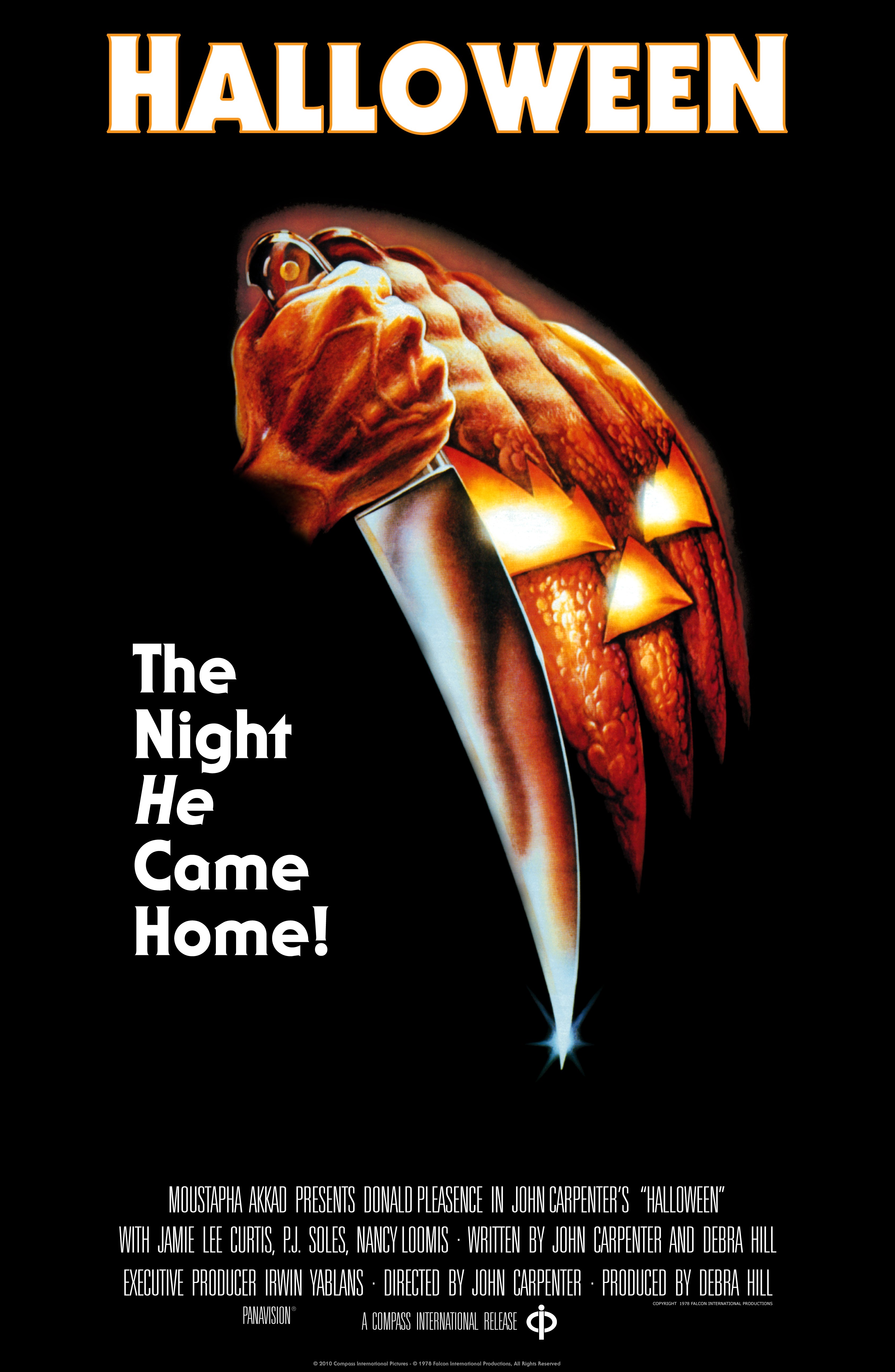
understory:
* Granted, it landed a touch better in the early screening, but I think that was because—correct me if I’m wrong—the line initially got said twice, the second time on that character’s off-screen exit from the kitchen. In the theatrical cut playing now, he DOES say there’s peanut butter on his penis, but when he’s leaving it becomes peanut butter on his hand, mumble mutter. But oh well. I only noticed “penis” missing because that was such a good laugh (or, yes, wishful hearing) the first time around.
** And, talking comedy and this Halloween, there’s one line they SO could have capitalized on: when Laurie tells her daughter that it’s all about ‘preparing and protecting,’ the daughter says back that she’s preparing dinner, ha ha. To me, that line lands so much better if the daughter says she’s preparing dinner to protect her family from starvation, Mom.
*** If I’m wrong or overstepping or unfairly reducing or casting feminism in a bad light here, somebody tell me, maybe? I’m not the or even AN authority, am just a guesser, a sometimes-figure-outer.
**** People always wonder why there’s so many more final girls than there are final boys. I think it’s some inbuilt prejudice—at one time it was a bigger reversal if the GIRL was suddenly a strong fighter than that the BOY, who’s ‘expected’ to have been a fighter (through socialization, media conditioning, I don’t know). Or? It could be that, when faced with a MALE slasher, which is nearly always the case, a WOMAN standing up to him is a much sharper contrast?
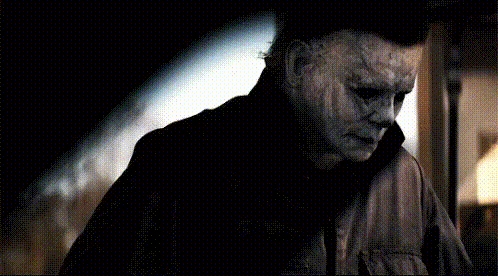

 is the NYT bestselling author of 30 or so books, +350 stories, some comic books, and all this stuff here. He lives in Boulder, Colorado, and has a few broken-down old trucks, one PhD, and way too many boots. More
is the NYT bestselling author of 30 or so books, +350 stories, some comic books, and all this stuff here. He lives in Boulder, Colorado, and has a few broken-down old trucks, one PhD, and way too many boots. More